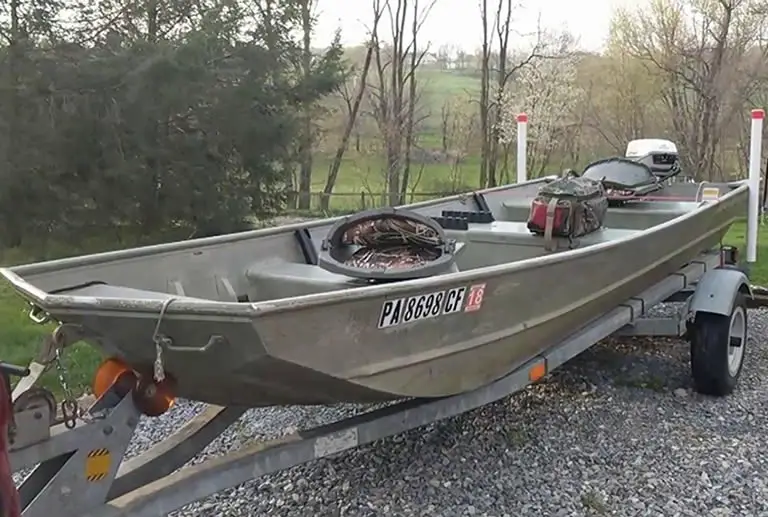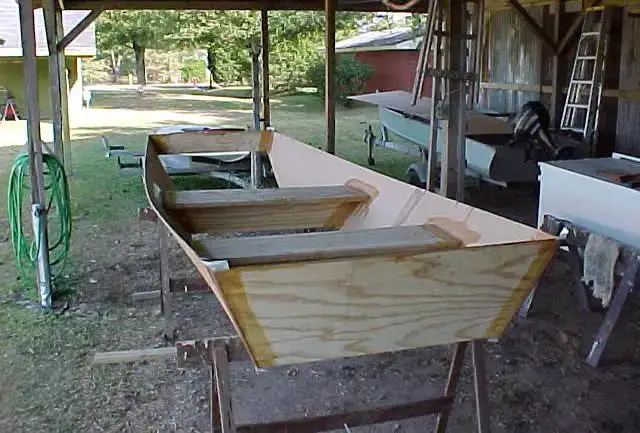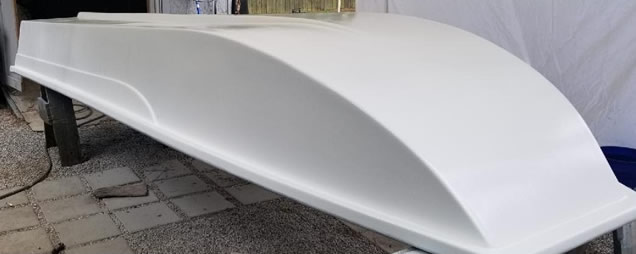Jon boats are versatile flat-bottom vessels that are most commonly made from aluminum.
However, fiberglass and wooden Jon boats do exist, though they are much less common.
Store-bought Jon boats are mainly aluminum while most home-made Jon boats are usually constructed using marine grade plywood or fiberglass or a mixture of the two.
Contents
Construction materials used for Jon boats
Below we look at the different materials that are used to make Jon boats.
Although there are different types of Jon boat, from the standard flat-bottomed Jon boat to the Mod-V Jon boat, the type and style of the Jon will not affect the material used to make it.
If you are unsure of the difference between a flat-bottomed Jon and a Mod-v Jon read this article.
Although there are different materials used to make Jon boats you should note that the most common material used is aluminum.
Common materials used to make Jon boats:
- Aluminum (most common).
- Wood.
- Fiberglass.
Let’s take a closer look at these materials to see what advantages and disadvantages they have.
Aluminum
By far the most common material used to make Jon boats is aluminum.
About 95% – 98% of all Jon boats are made from aluminum.
Why is this?

Well, aluminum is a very lightweight material that is fairly easy to work with.
This makes it advantageous to manufacturers and boaters alike.
As aluminum is easy to shape and work with manufacturers can easily build these boats in bulk keeping the prices down (though there are some expensive Jon boats these vessels are fairly cheap).
Likewise, the lightweight nature of aluminum means Jon boats are easy to transport.
They are also easy to get in and out of the water without the need for unloading the boat or loading the boat on a trailer in the water (though of course you can do this).
This makes them popular with boaters.
Aluminum also lends itself well to the construction of flat bottom, low freeboard boats, like Jon boats, because it is an easy material to work with.
As Jon boats tend to be used in areas on water that have extensive shallows, such a rivers, the bottom of the boat is prone to impact damage.
Or at least it would be if it were made from a non-impact-resistant material.
Aluminum can take some serious abuse before it shows signs of wear.
An an aluminum Jon boat would have to take some serious heavy impacts before it started to show signs of the collision.
Even if dented it is relatively easy to repair the metal and get it back into shape.
What’s more, aluminum tends to slide more easily over obstacles than other materials so it is less likely to get damaged in the first place.
The aluminum flat bottom on a Jon boat means the boat is much more likely to slide over any obstacles on the bottom than it is to snag on them.
The only problem you will encounter when using an aluminum Jon boat is when you take your boat into saltwater.
Although some people do use Jon boats in the ocean or in other saltwater environments aluminum does not react well to the salt in the water.
Saltwater is highly corrosive to aluminum and Jon boats that are made from it will get damaged by galvanic corrosion if they are not properly protected.
We covered this subject in detail in this article.
If you plan to take your aluminum Jon boat into a saltwater environment then you should read the above mentioned article. It is important you understand the essential steps you need to take in order to protect your vessel from the fast-acting negative effects of galvanic corrosion.
Wood
Almost all Jon boat home-build projects are made of wood.
Though you will find some fiberglass home-builds, wood offers much more benefits for the DIY boat builder.
DIY boat builders will almost always rely on marine grade plywood to make a sturdy, water-resistant, lightweight boat.
With the aid of some good boat building plans anyone can build their own Jon boat from marine plywood.
Marine grade plywood is easy to work with and easy to shape. It is also extremely lightweight.

What’s more, once a plywood boat is painted or stained it looks awesome!
Of course wood is not as resistant to corrosion or damage as aluminum and a Jon boat made from wood will certainly not last as long without some serious and consistent TLC.
However, a well-cared-for wooden Jon boat can last decades so you shouldn’t consider one to be an inferior boar or merely a short-term boat.
A well constructed, well-protected and well-cared for wooden Jon boat will offer all the same advantages of any other Jon boat that is made from a different material.
We demonstrated how easy it is to build your own flat bottom Jon boat here.
Fiberglass
Fiberglass Jon boats are constructed from fiber sheets that have been bonded together with resins to form a type of composite material.
This fiberglass composite material is extremely hard-wearing and very durable.
Fiberglass is also very easy to mould and shape making it a perfect material for boat construction.
Fiberglass is sometimes called Glass reinforced plastic (GRP) or Fiber reinforced plastic (FRP).
These names should give you some indication of just how tough the material is (there’s a reason why whitewater kayaks are made of plastic).
Although fiberglass is naturally water-resistant additional steps are taken to protect the boat further.
Over the fiberglass composite shell of the Jon boat, manufactures, or home-build enthusiasts, will often add a gelcoat finish. This provides additional protection to prevent water damage that could possibly occur if water leaked into the fiberglass layers.
Fiberglass is a durable material because it is corrosive resistant, and a Jon boat made of it will be durable and also impact-resistant.
Additionally, fiberglass is not open to the same type of quick and devastating corrosion from saltwater that aluminum is.
Thus fiberglass offers many of the advantages of aluminum but gives the added advantage of being capable of saltwater use without the need for any special treatment and maintenance.
Fiberglass is also much more resilient and water-resistant than wood.
So, why isn’t fiberglass a more popular option for Jon boat construction?
It’s because fiberglass is a lot heavier than aluminum and wood!

The heavier nature of fiberglass makes it a much less popular option for Jon boat construction.
This is because Jon boat owners want their vessels to be light enough to make them easy to transport and even portage (like a canoe) from one body of water to another when necessary.
Even as a home-build project most DIY boat builders will use wood instead of fiberglass simply because they will end up with a lighter boat
. However, many home boat builders will add a layer of fiberglass over their wooden boats and then cover it with a gelcoat.
This ensures they have all the benefits of a lightweight wooden boat with the added protection offered by fiberglass.
If you choose to build a Jon boat using only fiberglass then be aware that the build will be much more expensive than it would be if you used marine plywood.
This is obviously due to the materials used and the equipment needed to finish the project.
You will also end up with a fairly heavy boat.
Why use these materials and not others?
The above materials are chosen for Jon boat construction due to where these boats are used and how they are used.
The materials that are commonly used to make a Jon boat are chosen for their:
- Lightness.
- Durability.
- Corrosive resistance in freshwater.
- Impact resistance.
Because Jon boats are used almost entirely on inland bodies of water that have extensive shallow areas, with potentially rocky or debris-ridden bottoms, they need to be tough.
So they need to be made of a tough material.
The material used to construct a Jon boat also needs to be lightweight as these utility vessels are often hauled into and out of the water by hand without the aid of a trailer or dock.
Obviously the bigger Jon boats will require some form of trailering.
But most Jon boats, because of their flat bottom, can be easily pulled or pushed into and out of the water.
They can even be dragged over distance to be hauled onto a trailer or the back of a truck.
The material used for making a Jon boat must also be durable. Jon boats are utility vessels that are often used daily and they are used for a range of different activities.
So, the material used for their construction should be durable enough to take prolonged and regular use without sustaining damage or needing excessive maintenance.
The materials used for the construction of a Jon boat must also be water resistant.
As Jon boats are almost always used in freshwater environments, because they are inland waterway boats, they don’t require the same type of protection as saltwater vessels.
So the material used to make a Jon boat merely needs to be water-proof or be able to be easily treated with a product that makes it water-proof, (as is the case with wood).
Unlike saltwater vessels that need proper corrosive protection and regular maintenance.
As Jon boats are used in shallow water areas, such as rivers, they tend to venture into very skinny water.
Obviously this leaves the bottom of the boat open to impacts from collisions with debris at the river bottom.
Although the flat bottom hull will usually slide over any obstacle the boat encounters, jagged rocks could potentially tear at the hull.
So an appropriate material is needed to ensure the boat is not susceptible to sinking due to impact damage.
Aluminum and fiberglass Jon boats will slide easily over obstacles and show little signs of damage even when they encounter jagged rocks or debris.
Wooden Jon boats will not fair as well unless they have been treated with a layer of fiberglass or other hardened material on the bottom of the hull.
